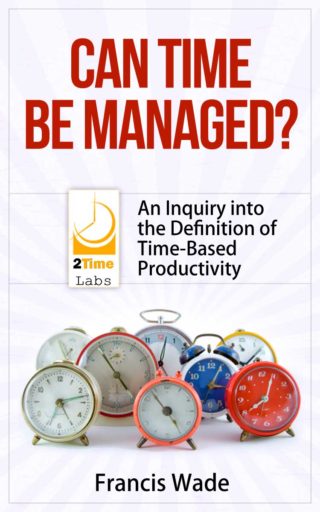Two years ago I embarked on a journey to answer: “Can time be managed?” and “Is time management truly possible?” Up until then, I had only complained. After all, claims that the phrase “time management is a misnomer” could be heard everywhere. While I habitually echoed the cliché, which sounds plausible when repeated, I felt uneasy… I couldn’t find a shred of proof.
Now, I do have findings to share based on studies of fields as diverse as anthropology and physics.
Discovery 1 — Time can be managed, but only in marginal ways
Chasing down a meme like “time cannot be managed” is tough work. Someone who is trying to justify the statement should do more than sling around clichés. He/she must track down every single definition of the word “time” in order to make sure it cannot be “managed.” It also means testing different meanings of the word “manage” to ensure that all reasonable descriptions are accounted for.
On my journey, I learned that “time” can be thought of in two ways. Either it’s taken to be “physically real” or it’s seen as a “psychological object.”
In the former interpretation, human beings have apparently made a mistake based on our studies of young children and un-contacted tribes. We have confused “Clock and Calendar Time (CCT)” with “event sequences.” CCT, which was invented around the end of the first millennium, is a skill which must be taught, usually to children. The same applies to tribes who simply don’t use the concept.
How do they survive?
They use “event sequences” made up of chains of “before-and-after” descriptions. They acknowledge the permanence of these sequences and describe the past in terms of its relationship to key events, such as the birth of a child.
“Event sequences” cannot be managed in any way. They just are.
However, CCT is constantly being “managed” if we accept a weak definition of the verb “manage”. Instead of equating it with interpretations linked to “control” or “dominate”, we can take it to mean “manipulate, influence, shape, engineer, steer.” When we adapt this particular meaning we discover that there are ways to “manage CCT.”
For example, in the modern world, we have accepted the need to add leap seconds. In the Ethiopian, Chinese, Baha’i, and Islamic calendars a leap year is added to prevent synchronization problems at different intervals.
So, there are ways for societies to “manage” “time”. Unfortunately, an individual can only do so if he/she has the power to set up his/her own calendar, perhaps by living on a desert island. In the rest of the world, we are constrained in our management of CCT by each other.
When we flip over to the alternate definition of time as a “psychological object” we see that a similar limitation applies.
If time is nothing more than a creation of the mind (according to physicists like Albert Einstein) we should expect it to be manageable. After all, products of your imagination should be quite malleable.
In fact, there is historical evidence that it used to be. The invention of time zones went through several stages where cities like Detroit saw dramatic clock changes as the definition matured.
Today, however, there is no such freedom. Theoretically, problems like the Millennial Bug or Y2K Problem should have been fixable by simply setting back our clocks by, say, 99 years. While it would have worked in centuries past, in 1999 it was an unworkable idea which would have led to far greater problems. This particular psychological object has become so rooted in human affairs that we cannot escape its grasp. Only our friends in un-contacted tribes are exempt.
In the future, we may come up with ways to manage time as a psychological object — it’s entirely possible. But once again, it’s a severely limited possibility.
While there are ways to resolve the misnomer by finding ways to “manage” “time” they are extremely minor, living only on the margins. They have little impact on our daily lives.
Discovery 2 — We still want “time management”
However, these truths don’t stop us from trying to improve our time-based productivity. After all, the phrase “time management” was invented in order to express an improvement we, as humans, have been trying to effect ever since the dawn of our existence.
It’s a response to real errors we see taking place every day: late arrivals, forgotten tasks, email overload, multi-tasking, stress, overweight, etc. These are examples of real, human problems which don’t have easy solutions. In lieu of concrete descriptors, we refer to the default problem as one of “time management.” And we want a fix.
In response, history shows that we have assembled a variety of schools of thought. Each of them gives a different meaning to the phrase that far surpasses the literal meaning of “time” or “management.” Now, the phrase “time management” can be taken to mean just about anything, including:
– A set of processes to follow.
– A specific end-result to be achieved.
– The secret of a person’s success.
– The reason for almost any identified failure.
This short list shows that we have granted the phrase a life of its own which has evolved over time. According to criteria set by researchers Geoff Bingham and Kurt Danziger, “time management” also qualifies as a psychological object.
As such, we need to be careful when using the phrase, because they indicate that people engage in what linguists call “language-games.” Over time, a number of different ones have evolved, even as they all sharing a common moniker.
If you observe conversations on the internet you can find well-meaning people belonging to different “language-games” trying to sort out common time management problems. The results are sometimes tragic, at other times comical. Unfortunately, when we can’t see the language-games at play these miscues are inevitable.
Take for example the time scarcity created by Type A individuals. To some, this is a problem to be eradicated.
For Type A’s, it’s a natural outgrowth of their ambitions. They have accepted that being alive means having more commitments than time will allow, forcing them to develop lifelong skills at setting priorities. Just imagine a coaching session between a professional organizer who believes scarcity is bad and a Type A client. Without a shared language-game, they end up in trouble.
Therefore, it’s critical that we account for existing language-games whenever the phrase “time management” is uttered. It’s the only way to appreciate the underlying context(s) being discussed.
Discovery 3 — There are much better ways to solve real problems than “time management”
Here’s a linguistic jujitsu trick we need to learn.
When someone mentions the phrase “time management” we need to determine not only which language-game they are playing, but also which specific problem they are trying to solve.
The fact is, most discussions in this realm surround intractable but practical symptoms of issues a person is trying to fix. The challenge is that, with a limited vocabulary, they only know to utter “time management.”
The recommended martial arts technique is simple. Set aside the issue of “time management”, while helping the other person to apply the best solution to the problem at hand. This calls for top-quality diagnostic skills.
Of course, the best way to empower others is not to diagnose their issues for them, but to teach them how to do so themselves. Once they become skillful, terms like “time management” fall away and more precise terms enter the picture. They accelerate their progress toward the answers they are looking for.
This inquiry into the existence of time management has helped me understand the confusion that slows people’s progress towards their goals. People must be able to get past the tangled question of time management’s existence/ definition in a single, short step. It’s a bypass that’s often necessary if practical solutions to real problems are to be found and implemented.
Click here to download “Can Time Be Managed? An inquiry into the foundations of time-based productivity”. Follow me on Twitter — @fwade





 I just posted a followup article on Medium that addresses the second component of
I just posted a followup article on Medium that addresses the second component of 


 I just released a new post on Medium about notifications, interruptions and notifications that will occupy the attention of 2Time Labs for the next several months.
I just released a new post on Medium about notifications, interruptions and notifications that will occupy the attention of 2Time Labs for the next several months.